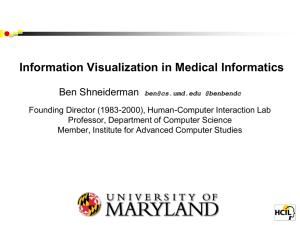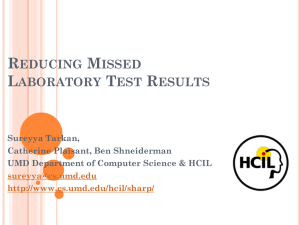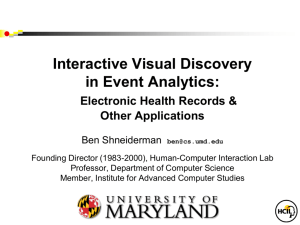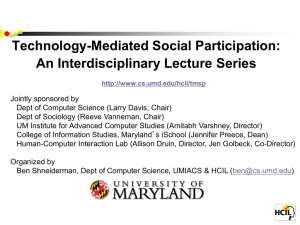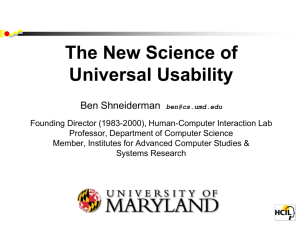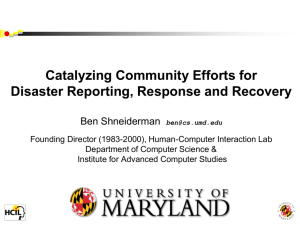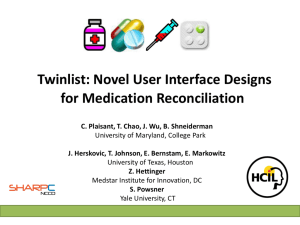Medical Informatics: Opportunities for Improving Patient Care Ben Shneiderman
advertisement
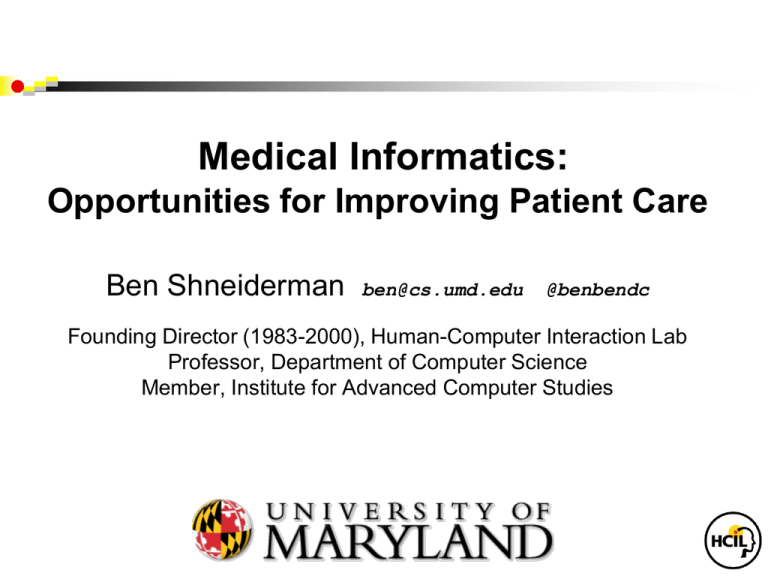
Medical Informatics: Opportunities for Improving Patient Care Ben Shneiderman ben@cs.umd.edu @benbendc Founding Director (1983-2000), Human-Computer Interaction Lab Professor, Department of Computer Science Member, Institute for Advanced Computer Studies IOM Report: Health IT and Patient Safety Problem - Poorly designed health IT can create new hazards in the already complex delivery of care. - Dosing errors, failure to detect life-threatening illnesses & delaying treatment due to poor HCI or loss of data have led to serious injury & death. Recommendations: - User-centered design & human factors applied to health IT www.iom.edu/Reports/2011/ Health-IT-and-Patient-Safety-Building-Safer-Systems-for-Better-Care.aspx Strategic Health IT Advanced Research Projects (SHARP): Office of National Coordinator - Security of Health Information Technology - Patient-Centered Cognitive Support - Healthcare Application and Network Platform Architectures - Secondary Use of EHR Data Sharpc.org www.cs.umd.edu/hcil/sharp HCIL’s Research Initiatives Medical Lab Tests - Tracking Completion in Complex Workflows - Guidelines for Design of Tables & Actions - Retrospective Analysis Medication Reconciliation Patient Histories – Analysis & Search - Temporal Event Sequences - Point & Interval Events Wrong Patient Errors (BONUS) Medical Lab Tests Tracking Sharpc.org www.cs.umd.edu/hcil/sharp Medical Lab Tests Tracking & Retrospective Analysis www.cs.umd.edu/hcil/sharp Medication Reconciliation: Current Form Univ of Maryland HCIL tasks - Missing Laboratory Reports - Medication Reconciliation - Alarms and Alerts Management www.cs.umd.edu/hcil/sharp www.youtube.com/watch?v=ZGf1EiuIIIM Prototype by Tiffany Chao VIDEO AVAILABLE AT www.cs.umd.edu/hcil/sharp Prototype by Tiffany Chao VIDEO: www.cs.umd.edu/hcil/sharp Prototype by Tiffany Chao VIDEO: www.cs.umd.edu/hcil/sharp Successful adoption efforts Example # 1: Twinlist running on Microsoft Amalga Platform Contact: Hank Rappaport Example #2: Twinlist adapted for problem list reconciliation in cancer risk assessment (Hughes riskApps™ - an EHR module) Contact: Kevin S. Hughes, Massachusetts General Hospital 10 Patient Histories: LifeLines www.cs.umd.edu/hcil/lifelines2 Patient Histories: LifeLines2 www.cs.umd.edu/hcil/lifelines2 Patient Histories: LifeFlow www.cs.umd.edu/hcil/lifeflow Patient Histories: EventFlow www.cs.umd.edu/hcil/eventflow Patient Histories: PairFinder www.cs.umd.edu/hcil/pairfinder Temporal Event Sequences Tool Event Types Records Display LifeLines Points & intervals One One record LifeLines2 Points Many Many records Similan Points Many Many records LifeFlow Points Many Many records & aggregate EventFlow Points & intervals Many Many records & aggregate PairFinder Points Many Temporal record distributions www.cs.umd.edu/hcil/lifelines2 /eventflow /pairfinder Reducing Wrong Patient Errors: Animated Transitions & Photos BONUS Reducing Wrong Patient Errors: Animated Transitions & Photos Reducing Wrong Patient Errors: Animated Transitions & Photos Reducing Wrong Patient Errors: Animated Transitions & Photos Error Recognition Rate for each Group 63 % 0.7 63% 43% 0.6 0.5 43% 36% 0.4 36% 0.3 0.2 7% 7% 0.1 0 Control Control Animation Animation Photo Photo Combined Combined The combination of animation & photo resulted in a significant increase in error recognition rate relative to the control & animation groups Dramatic implications for commercial systems (Taieb-Maimon, Plaisant & Shneiderman, 2012) Take Away Messages Healthcare is fertile area for HCI & InfoVis Patient Safety is a national priority We have tools for analysts Tomorrow: Workshop on EHR Informatics Thanks to: Oracle Corporation NIH/National Cancer Institute grant RC1-CA147489, SHARP grant 10510592 – Office of National Coordinator www.cs.umd.edu/hcil/sharp www.cs.umd.edu/hcil/lifeflow /eventflow /pairfinder
